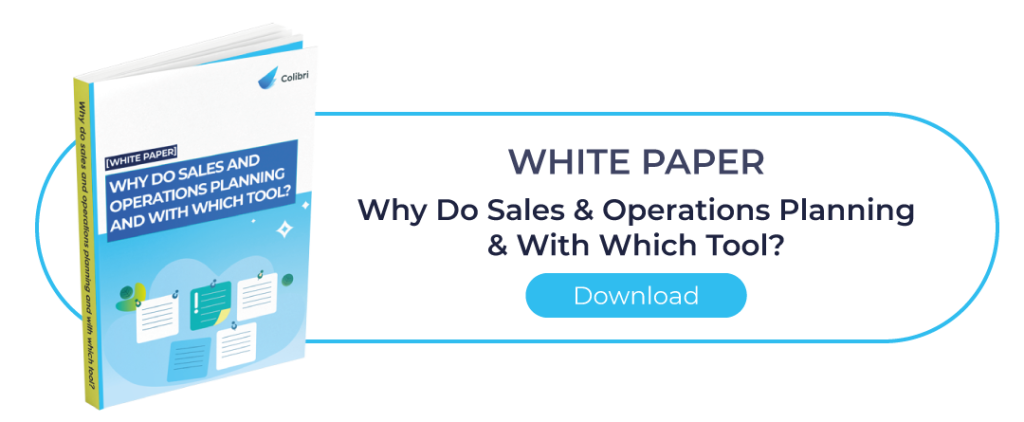The environmental impact of companies has become a hot topic. Decision-making is no longer based on price only; it also considers indicators such as CO2 emissions. Companies are now making more informed (and responsible) decisions about the kind of products they manufacture, where they do it, and in what quantities. The carbon score is therefore becoming an increasingly important indicator in decision making, particularly in the context of the S&OP process. Let’s take a look.
S&OP: Why it is important to integrate the environmental impact into decision making
S&OP or how to strategically steer the company’s activities
Sales and operations planning aims to define a medium-term operational strategy to meet market demand: what products will customers buy? In which quantities? At what time of year? Based on these elements, tactical plans are developed – each strategy having various impacts on costs, team organization, or carbon footprint.
S&OP is primarily based on the removal of silos between business functions. The process brings together the separate plans into an integrated set of plans: business development, sales, marketing, procurement, production, and finance; S&OP is a cross-functional project for the entire company. And what could be more cross-functional today than the environmental issue?
The environmental impact at the heart of corporate and consumers concerns
Today, companies are increasingly concerned about their environmental impact for two main reasons. First, because of a general awareness. Companies are increasingly adopting an eco-friendly approach by committing to environmental charters and integrating this approach into their brand identity. Second, because regulations are changing. Environmental responsibility taxes, carbon tax or anti-waste laws: the government now imposes environmental good practices on companies. Article 1 of the Climate and Resilience Bill also plans to introduce a carbon score for all consumer products and services. Displaying the CO2-score will be progressively made mandatory so that consumers know the greenhouse gas emissions impact of the goods and services they buy.
Consumers are also paying more attention to the environmental impact of their purchases than ever before. For instance, 75% of the people in France say they are concerned that the goods they buy are produced locally. A study conducted by Oney and Opinion Way on sustainable consumption in Europe (2020) shows a similar concern: 90% of European consumers say they are concerned about the environmental impact of their purchases and feel they are taking action to achieve sustainable consumption. The study also shows that consumers care about the brands’ environmental commitments when they make a purchase.
The environmental impact is a more pressing concern than ever, both for companies and for their customers. Environmental indicators must therefore be taken into consideration when making decisions.

CO2 emissions: an essential KPI in an era of corporate eco-responsibility
The emergence of new rules and regulations and the collective interest in the environmental impact of consumption are leading companies to adapt their practices. Environmental performance is thus receiving more and more attention. In this context, CO2 emissions need to be closely monitored.
Key performance indicators (KPIs) are used to evaluate a company’s performance against its objectives. Environmental objectives must now be included in the company’s strategy to win the hearts of consumers – and comply with regulations.
The CO2 emissions generated by the company’s activity must therefore follow management rules and be regularly analyzed. A strategy can thus be established, and processes adapted if the company’s results do not meet the set objectives. The carbon tax, based on the “polluter pays” principle, also deserves to be closely monitored as the amount owed by the company depends on its environmental impact. In addition to giving rise to a financial evaluation, a dedicated KPI gives the company the opportunity to readjust its operations. Ultimately, environmental KPIs can serve the company’s brand image: it becomes possible to communicate transparently about its (low) environmental impact.
Also read : Chaîne logistique et impact environnemental : à quand une obligation du « mieux prévoir » ?
Carbon score: what if this indicator served your business?
In addition to serving transparency and the company’s brand image, the carbon score provides a definite business advantage. To understand this, let’s take a look at two S&OP simulations:
- Manufacturing a product in Thailand: costs are reduced but the carbon footprint does not meet the requirements of French consumers in terms of environmental responsibility.
- Manufacturing the same product in France: production costs are higher, but the brand can expect to achieve more sales thanks to the lower environmental impact of the product. This appeals to customers, some of whom are willing to pay more.
Environmental indicators can be a selling point for an increasing number of consumers. Inviting them into the decision-making process can have a positive impact on your sales, in addition to demonstrate that you are a committed company.
Planning tools and environmental indicators: an opportunity
In such a context, it is not unreasonable to expect planning tools to include the concept of environmental impact in their forecasts. Although CO2 emissions and carbon tax are KPIs that are rarely included, solutions like Colibri already offer the possibility to integrate S&OP simulations that do take into account the environmental impact. It is therefore possible to make informed decisions to minimize environmental impact now.
As an S&OP tool, Colibri allows you to manage your Sales and Operations Planning from A to Z, to simulate, compare and make the right decisions according to your environmental objectives. Do you have a project? A question? Contact us now!






